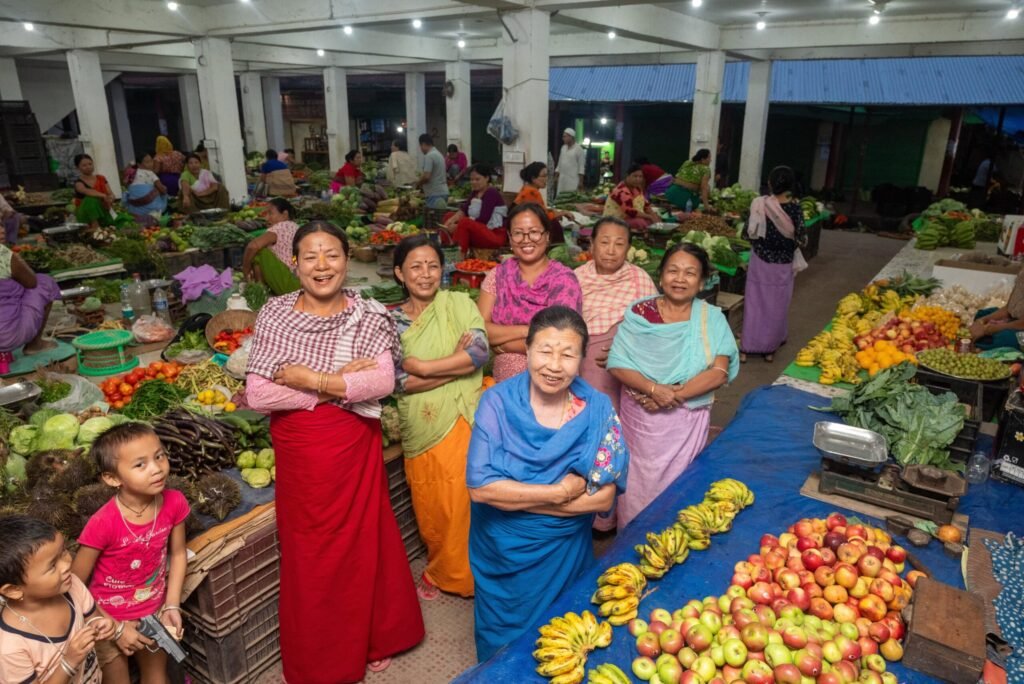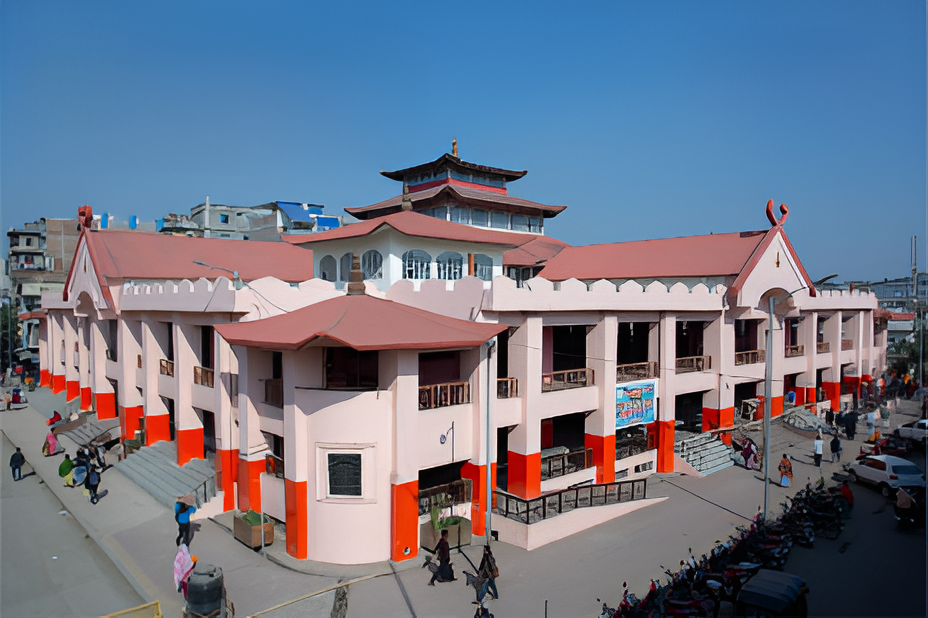Khwairamband Bazar, popularly referred to as Ima Market or Nupi Keithel, stands as Asia’s largest and oldest all-women-run marketplace, located in the dynamic heart of Imphal, Manipur. This vibrant hub of commerce and culture has blossomed for over 500 years, representing not only economic empowerment but also the rich traditions and resilience of Manipuri women. As a must-visit tourist spot and local treasure, Ima Market invites visitors to experience its historical significance, grand architecture, festive atmosphere, and deep social roots.
Architectural Layout & Location
Located centrally in Imphal, Ima Market is easily accessible and positioned around the Bir Tikendrajit Road, within Khwairamband Bazaar. The market comprises three main complexes:
- Leimarel Shidabi Ima (Purana Bazar): oldest and largest, north of the main road
- Emoinu Ima Keithel (Laxmi Bazar): smallest, also north
- Phouoibi Ima Keithel (New Market): known for textiles, south of the road
Each section caters to a distinct set of products, from groceries to intricate handlooms and crafts. Outside, tin and tarp stalls line the eastern part, welcoming newer vendors.
How to Reach Khwairamband Bazar
Imphal is served by Bir Tikendrajit International Airport, offering direct flights from Kolkata, Delhi, and Guwahati. From the airport, Khwairamband Bazar is a short drive via taxi, auto-rickshaw, or public transport. The market is centrally located, making it easily accessible for tourists and locals alike.
Key Details:
| Feature | Details |
|---|---|
| Location | Central Imphal, Manipur (west of Kangla Fort, on Bir Tikendrajit Road) |
| Unique Aspect | Asia’s largest all-women market; only women vendors, no male shopkeepers allowed |
| History | Over 500 years old; established in the 16th century |
| Cultural Significance | Symbol of women’s economic power; run mainly by married, widowed, or divorced women |
| Number of Vendors | About 5,000–6,000 women vendors sell goods daily |
| Main Products | Vegetables, fruits, textiles, handloom, toys, fish, spices, utensils, jewellery, and local crafts |
| Market Sections | 3 buildings: Leimarel Shidabi Ima (oldest), Emoinu Ima Keithel (smallest), Phouoibi Ima Keithel |
| Visiting Hours | 7:00 am – 5:00/7:00 pm daily |
| Best Time to Visit | Morning (for freshness, lively atmosphere) |
| Entry Fee | No entry fee |
| Vendor Stall Fee | Approx. ₹1,40,000 per annum for a 16 sq ft stall (for vendors) |
| Average Vendor Income | Annual profit ₹73,000–₹2,00,000 per vendor |
| Total Market Turnover | Estimated ₹40–50 crore annually |
| Management | Managed by vendors’ union; licensing system in place |
| How to Reach | Located in Imphal city center: |
| – By Auto-Rickshaw | ~10–15 minutes from most city points, ₹20–₹50 per person |
| – By Walking | 10–20 minutes from the city centre |
| – By Bicycle | Easily accessible, rental possible |
| Nearby Places | Kangla Fort, Thangal Bazar, Paona Bazar |
| Other Tips | Bargaining common, bring cash, try local street food |
| Popularity | Major city attraction, social hub, tourist hotspot |
History of Khwairamband Bazar / Ima Market
Dating back to the 16th century, the origins of Ima Market are intricately linked to Manipur’s lallup-kaba, a forced labour system that sent men to work in distant lands or military service. In response, Manipuri women began cultivating and trading goods to support their families, eventually formalising the market as the “Mothers’ Market.” Ima Keithel (“Mother’s Market”) continues the legacy of women’s wartime resistance, most notably in the Nupi Lan (Women’s War) movements against colonial policies, and has become pivotal in political and economic matters since independence. After several architectural transformations, including major expansions in the early 2000s and post-earthquake reconstructions, today’s market features three pagoda-style buildings brimming with life and activity.
Women’s Economic Power and Management
Ima Market is unique as the world’s only marketplace where all 5000-6000 vendors are women, often aged 45-70, from diverse ethnic backgrounds, including Meitei, Naga, Kuki, Muslim, Bengali, and more. Only women who have been married at least once, whether widowed, divorced, or retired, and who are referred by a vendor, may operate stalls. Management is led by highly organised unions and committees that oversee operations, licensing, credit, and conflict resolution.
Taxes, Revenue & Finances
Vendors pay annual stall fees of around ₹140,000 per year as of 2010; general and road taxes average ₹30 to ₹50 per month, with additional levies for roadside stalls. Depending on the season and product, profits range from ₹73,000 to ₹200,000 per year; festive periods such as Ningol Chak Kouba, Cheiraoba, and Yaosang draw larger crowds and higher revenues. The bazaar’s annual turnover is estimated at ₹40–50 crore, amplifying its significance in Manipur’s socio-economic landscape.
Culture and Traditions
Places to visit in Kolkata: Where Culture Breathes, History Lives, and 20+ Places That Tell the City’s Story. Ima Market isn’t just a commercial hub; it’s a living museum of Manipuri tradition. Celebrations take place throughout the year, featuring indigenous crafts, textiles, foodstuffs, and rituals tied to cultural festivals like Lai Harouba. Visitors can witness the market’s role as a community space, supporting not only business endeavours but also social causes, women’s activism, and community lending practices (“Selep Mutpi money lending”).

Notable Attractions & Nearby Places
Khwairamband Bazar is surrounded by a wealth of tourist sites, perfect for building an unforgettable itinerary:
- Kangla Fort: historic fortress, major landmark
- Manipur State Museum: artefacts and exhibits
- Chorus Repertory Theatre: performing arts centre
- Shaheed Minar: freedom memorial
- Handwoven Cane Baskets & Wooden Furniture Markets
The vibrant marketplace also features convenient food stalls, tea vendors, metal and wooden jewellery, and regional handicrafts made by Manipuri men.
List of Market Segments
- Leimarel Shidabi Ima (Oldest groceries)
- Emoinu Ima Keithel (Laxmi Bazaar, mixed goods)
- Phouoibi Ima Keithel (Textiles, handlooms)
- Linthoingambi Keithel (Clothing)
- Yenyonfam Keithel (Seafood, Muslim traders)
- Imoinu Keithel (Mixed, includes non-local vendors)
- Nagamapal Keithel (Kuki/Naga traders)
- Punshi Keithel (Naga traders)
Recent News & Developments
In 2025, Ima Market gained international acclaim, hosting delegates from B20/G20 forums and launching new initiatives to boost tourism and local heritage. Its expansion and resilience, even after natural disasters like the 2016 earthquake, underscore the adaptability and innovation of Manipuri women.
FAQs About Khwairamband Bazar / Ima Market
Why is Ima Market famous?
Ima Market is world-renowned as Asia’s largest and oldest all-women marketplace, celebrating economic empowerment and centuries-old traditions.
What can visitors buy at Ima Market?
Shoppers can find handmade textiles, crafts, traditional foods, fresh produce, jewellery, and souvenirs unique to Manipur.
Are men allowed to run shops in Ima Market?
No, only women, mostly those who have been married, widowed, or divorced, are permitted to run stalls; men participate as artisans, porters, or customers.
What is the best time to visit?
Festive seasons such as Ningol Chak Kouba, Cheiraoba, Yaosang, and Lai Harouba bring more activity and vibrant displays, but the market operates daily from 9 AM to 7 PM.
How is Ima Market managed?
Vendor unions and joint committees oversee licensing, lending, arbitration, and event organisation, upholding traditions and inclusive management.
What are some places to visit near Khwairamband Bazar?
Nearby attractions include Kangla Fort, Manipur State Museum, Shaheed Minar, Chorus Repertory Theatre, and artisan markets.
How do women vendors benefit from Ima Market?
Vendors gain economic independence, social recognition, and a supportive community, with organised lending schemes and unions fostering women’s welfare.
